
This set visit piece will contain minor spoilers for His Dark Materials: The Golden Compass.
Standing in a vast expanse of green, the young girl hugs a disembodied polar bear head. She cries and speaks, inaudibly where I’m standing, to the head, which responds to her in an equally disembodied voice that is loud, gravelly and probably on tape somewhere. “I will try, Lyra Silvertongue,” the voice rumbles.
This is the set of The Golden Compass, the film adaptation of the first book in Philip Pullman’s His Dark Materials trilogy, which is in its final week of shooting at England’s Shepperton Studio. I am standing with the biggest group I have ever been with on a set visit – someone has counted fifty of us, which means that we easily outnumber the crew here shooting climactic moments at the end of the film. Most of the people here are foreign press, and I wonder how much of any of this business makes sense to the big gaggle of Japanese women.
The Golden Compass is perhaps the most straight ahead of Pullman’s trilogy, and the easiest to translate into a movie – Lyra lives in a world similar to ours, but also strikingly different, with talking armor-wearing polar bear warriors and witches who fly on tree limbs and massive zeppelins that cruise the sky. Maybe the most important difference is that every person in this world has their soul on the outside of their body, in the form of a daemon, which takes the shape of an animal familiar. Lyra lives on the grounds of Jordan College in 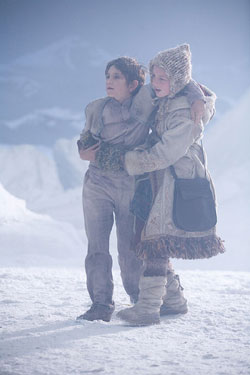 Oxford when mysterious Gobblers begin abducting children. Lyra gets caught up in events surrounding the Gobblers and their dark mission, traveling first to London and then to the frozen arctic north, where she discovers the terrible truth of why the children are being kidnapped and, together with a motley crew of friends that includes gypsies, polar bears and a cowboy, puts a stop to it.
Oxford when mysterious Gobblers begin abducting children. Lyra gets caught up in events surrounding the Gobblers and their dark mission, traveling first to London and then to the frozen arctic north, where she discovers the terrible truth of why the children are being kidnapped and, together with a motley crew of friends that includes gypsies, polar bears and a cowboy, puts a stop to it.
The scene we briefly see being filmed takes place right at the end of the film, as Lyra, played by newcomer Dakota Blue Richards, takes her leave of her friends and begins the next step of her adventure, which continues in the book The Subtle Knife (and the movie as well, should this film do well enough, but more on that later). Shepperton’s Stage H has been transformed into a giant green screen, with crosses peppering the walls as reference points for the computer animators. Richards and the bear head – it’s controlled with a rod by a group of puppeteers – stand on a small patch of fake white snow amidst all the green; while the snow is fake the cold is real, with crew member’s breaths coming out in thick mists. It must be easy for Richards to pretend to be far above the Arctic Circle; less easy is crying, and so she has crystals blown into her eyes between takes to stimulate real tears.
Director Chris Weitz sits huddled by a portable heater in the video village, watching the scene on a monitor. The camera is positioned over the shoulder of the bear – named Iorek – so no facial movement is needed, but there’s another bear head, this one all green, that I assume will be used in shots where expressions and lip synching need to be added in later. Weitz says hello, but the crew is pressed for time in the final days, and there are just an overwhelming number of us, so there’s no opportunity for interviews. Sadly, there are pretty much no interview opportunities at all, only time given for presentations.
After watching a couple of takes, our massive group is shuffled off for just such a presentation. The adjoining stage has been turned into an ersatz Golden Compass museum – parts of sets are displayed, as are costumes. In one corner is an antiseptic, heavily plasticized bit of set from Bolvangar, where the Gobbler experiments are carried out. In another corner is the massive carriage from cowboy and aeronaut Lee Scoresby’s balloon (Scoresby is played by Sam Elliott, the modern living embodiment of the West). Elsewhere are a couple of pieces of set from the living quarters of the glamorous and cruel Mrs. Coulter, played by Nicole Kidman, including a living room set topped off with an oil painting of Coulter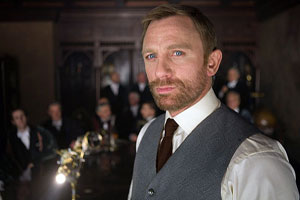 and her daemon, a golden monkey.
and her daemon, a golden monkey.
In addition to the sets and costumes, the stage includes a long wall covered with concept art, arranged chronologically across the storyline. The basic visual building blocks of the film are here, from Jordan College to a polar bear duel to the death on the ice to a massive rip in the fabric of reality leading to another dimension… and the next film. Production designer Dennis Gassner gave us a presentation, walking us through the concept art, and we were also shown about ten minutes of the film in scenes taken from the entire length of the story. Looking at the art and watching the footage it became immediately apparent that this film is going to be remarkably faithful to Pullman’s literate and sober novel. Weitz and his crew haven’t punched up the story with extraneous comic relief or added action scenes that aren’t in the text. With some major thematic exceptions (more on that soon), this is Pullman’s book done in a way that is sure to delight fans of the property.
The ten or so minutes we see doesn’t have the effects in place – at one point we see a scene with Lyra walking and talking with her daemon, Pantalaimon, who is quite noticeably not visible yet – and the sound isn’t mixed. It’s not an ideal way to see footage from a film like this, which will have FX in almost every single shot as all the daemons (except those in the form of dogs) will be created in computers, but we do get a feeling for the film’s visual aesthetic, which is rich, with the early scenes bathed in golden light. We also get to see Daniel Craig in action as Lord Asriel, Lyra’s uncle who has a small but crucial role in this film and a larger, more central one in the third book, The Amber Spyglass. Craig proves that the difference between himself and the other James Bonds is that he’s an actor – the man is completely different in every way from any other Daniel Craig role. Lord Asriel is only in two sequences in this film, and I think we’re going to miss him when he’s offscreen.
Dakota Blue Richards seems fine enough in the quick moments we see of her, but in just a couple of seconds Sam Elliott blows everyone else away. There is not even close to enough footage of Eva Green in billowy silks as the witch Serafina Pekkala. In general we see enough 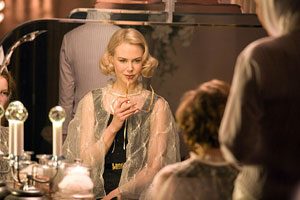 to prove that this is a movie whose budget – according to some reports 150 million dollars – is on screen.
to prove that this is a movie whose budget – according to some reports 150 million dollars – is on screen.
After some more presentations, including a bit about the CGI creation of Iorek (sad but true – any CGI footage of polar bears calls to mind Coca Cola commercials. This is going to be a minor hurdle to overcome in the earliest trailers), we are herded to the next stage, where we get a stunt and gunplay demonstration. We see the stunt crew working out a large fight scene that includes more than half a dozen participants; on hand is Dakota Blue’s stunt double, an 11 year old martial arts champion. I find myself delighted by the very tiny and compact, almost midget adult stunt people playing children (the fight being rehearsed is the massive escape from Bolvangar) and also by how the stunts are infused with a sense of play; when a stuntman raises a gun and pretends to fire it he says, ‘Ka-pow!’, and when stunt people throw punches they provide sound effects like kids acting out their favrorite scenes in action movies. Maybe more interesting, though, is the level of violence – the action on display ends with a number of people being stabbed and slashed to death. Definitely PG-13 material.
Next we’re shown the flying rig, which is used to allow the witches to take off and land, as well as against a green screen for all the flight close-ups in battle. Two journalists – the wrong ones (ie, neither was me, even after I raised my arm and ‘Ooh! Ooh!’ed like Horshack) – get done up in the crotch-coddling rig and twirled around in the air for a bit. As they do that, we’re given a demonstration of the different guns in the film as they’re each fired off. We put our fingers in our ears for each bang – some are quite loud while others are calibrated for scenes with child actors on set. None of them seem that awe-inspiring until we’re shown one (and damn my notes, I can’t tell you what it is – most of the guns are based on old firearms from the 19th and early 20th centuries, though. Most of the look of Lyra’s world is pre-WWII) that delivers a blast so loud I feel it in my balls. It’s like standing next to a thunderclap. Involuntarily I find myself grinning at the sheer awesomeness of the fire power.
The next day at lunch during the Inkheart set visit, also at Shepperton, I sat down with New Line exec Mark Ordesky. The Golden Compass is the easiest book to film, he admitted – The Subtle Knife will be the bear. It’s a more interior novel, with a scope that, while it traverses multiple alternate Earths, is actually smaller. And it doesn’t have a big set-piece like The Golden Compass’ Bolvangar escape finale. Still, looking to the big screen adaptation of The Subtle Knife may be premature (even though New Line has assigned a writer to take a crack at it – my advice is to fold the battle at the opening of the third book into the end of the second movie); if The Golden Compass does indeed cost 150 million dollars, the movie will need to make a lot of money to guarantee a sequel. It will need to be a massive blockbuster and prove to have a great life on video.
How to ensure that? One of the ways New Line has upped the sellability of The Golden Compass is to take the Church out of it. Pullman’s series is often described as the anti-Narnia, and over the course of the three books the writer posits the Church as the villain and Original Sin as a great moment in humanity’s history. He even has [swipe for spoilers] the death of God, who has been usurped by the angel Metatron, a very Gnostic look at the universe. [spoilers end]. The Church is now The Magisterium, a change that producer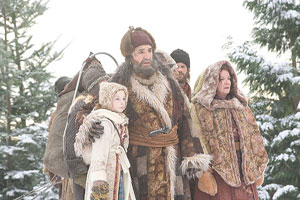 Deborah Forte – who has been working on getting this film made for 11 years – says Pullman is fine with. She told us that the change retained what Pullman’s real interest was, which is fascism and control. Which is fine, but in the books the fascism is spiritual and religious, and while the changes to the nature of the villains doesn’t have too much of an effect on The Golden Compass, the next two books are already at a disadvantage – one of the great mysteries of The Golden Compass is the nature of a strange phenomenon known as Dust, and the explanation of what Dust is will have to be massively revamped in the potential film versions of The Subtle Knife and The Amber Spyglass.
Deborah Forte – who has been working on getting this film made for 11 years – says Pullman is fine with. She told us that the change retained what Pullman’s real interest was, which is fascism and control. Which is fine, but in the books the fascism is spiritual and religious, and while the changes to the nature of the villains doesn’t have too much of an effect on The Golden Compass, the next two books are already at a disadvantage – one of the great mysteries of The Golden Compass is the nature of a strange phenomenon known as Dust, and the explanation of what Dust is will have to be massively revamped in the potential film versions of The Subtle Knife and The Amber Spyglass.
Again, though, future films are by no means assured. Unlike The Lord of the Rings, whose success New Line obviously hopes to at least partially ape, the His Dark Materials books are not being adapted all at once, and the studio still has the major battle of selling this property to people between now and December. Most of my set visits are embargoed until just a few weeks before a movie’s release – this visit has no embargo, probably because New Line wants to start the marketing and branding of the title and concept immediately. The throughline of The Golden Compass can be simplified, as I did in one of the opening paragraphs of this piece, but that simplification offers no real glimpse at what has made the books as popular as they are. It also doesn’t clue you in to why the books will never be as popular in the US as many other fantasy series – they are frankly too brainy, too interested in concepts before action, to appeal to most of the people who buy paperback sword and sorcery. And they’re definitely far smarter than the standard family film blockbuster. These are books that explore Gnostic belief and quantum physics, that take their overarching name from Milton’s Paradise Lost. And Pullman doesn’t stick to just one fantasy archetype for his books – there’s everything from steampunk to spellcasting here, a mix that isn’t familiar to moviegoers. What will your average audience make of a trailer that has armored polar bears, witches AND a cowboy?
If New Line does make a trailer that manages to include those disparate elements in a way that doesn’t confuse audiences, they can easily win the first weekend. But what then? This movie needs to be a huge hit, the kind of hit not made in three days. The Golden Compass ends on a very open note, much like The Fellowship of the Ring – but unlike that film there’s 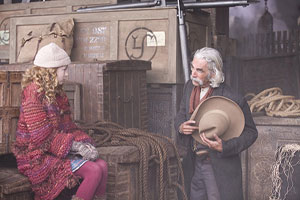 no guarantee of a follow-up in 12 months. Also, many of the film’s major questions remain unanswered at the end, left to be tied up in the following stories. Will audiences walk out of the opening weekend of The Golden Compass telling their friends that the movie doesn’t end, to wait for the next one and see this on DVD?
no guarantee of a follow-up in 12 months. Also, many of the film’s major questions remain unanswered at the end, left to be tied up in the following stories. Will audiences walk out of the opening weekend of The Golden Compass telling their friends that the movie doesn’t end, to wait for the next one and see this on DVD?
Let’s hope this does well. It’s too rare that cerebral books get adapted for the screen, especially as films aimed at wide and family audiences. New Line took one of the all-time great cinematic gambles with the Lord of the Rings trilogy, and that paid off beyond anyone’s expectations. Can they hit the same jackpot twice?